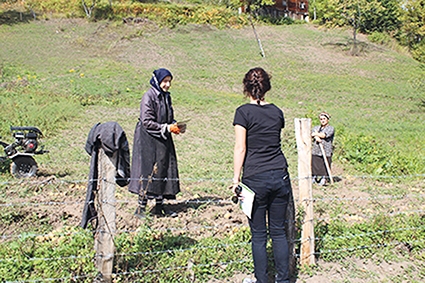Gender Inequality in the Countryside
Layers of dusky mountains with sheep grazing in the meadows; below, villages with ancient traditions, multicolored lakes surrounded by diverse wildlife, and... gender inequality. An EU-funded report published this October clearly underlines the difficulties for women in rural communities and agriculture.
Named “Gender, Agriculture and Rural Development in Georgia”, the report was undertaken as part of the project “Capacity Development of the Ministry of Agriculture of Georgia” with financial support from the Austrian Development Agency and the European Neighborhood Program for Agriculture and Rural Development.
“The social status of women in rural areas remains low,” states the report. Gender stereotypes lead many to believe that existing inequalities are natural or at least acceptable, which has a negative effect on many areas of women’s economic and development opportunities.
Firstly, women have worsened economic opportunities through the rigid division of gender roles. They are expected to take care of the household and be agricultural helpers (not managers). Girls, therefore, do not receive the same educational investment as their male counterparts, as their economic returns are perceived to be lower, meaning they have less access to well-paid jobs in the future.
Women working in agricultural roles are more likely than men to be unpaid workers, fuelling a significant gender pay gap. On average, women are paid 75% less than men in agriculture, hunting and forestry roles, and 35% less in fisheries. Nearly 60% of self-employed women are non-paid, the report claims.
Too often, women are seen as ‘wives of farmers’ whilst men are the ‘farmers’. Women working in agriculture are regularly excluded from communication and mobilization channels, with rural advisory services contacting a small number of male farmers who relay information to other men, not women. Although agriculture is predominantly masculine, the 9-25% of female employees miss out on information, knowledge and agricultural innovation which can hinder economic opportunity.
Limited access to ownership of land and other property also “diminishes their empowerment possibilities”. This doesn't just lower the status of women in and outside the family, women who own property are also less likely to suffer from domestic abuse, as they have a way out.
In addition, poor infrastructure and housing fuel gender inequality, in part due to the expectation of women to perform household chores. A lack of modern appliances means that simple tasks can take a long time. Transportation is also often difficult and slow. Women then have less time to learn and perform tasks that could earn money.
Gender inequality not only negatively affects women living in rural communities. The pressure put on men to be the breadwinners and providers for the family can lead to increased frustration and mental health problems. They are much more likely to drink alcohol and smoke. This increased frustration may be a reason why, shockingly, 81% of suicides in 2016 were men. Moreover, it can contribute to domestic violence.
Despite progress over the last two decades, there remains a gap between legislation, policies, and implementation to truly tackle the root causes of gender inequalities in rural areas. More research and changes around gender, food security, and agriculture are needed to truly see results.
By Amy Jones












